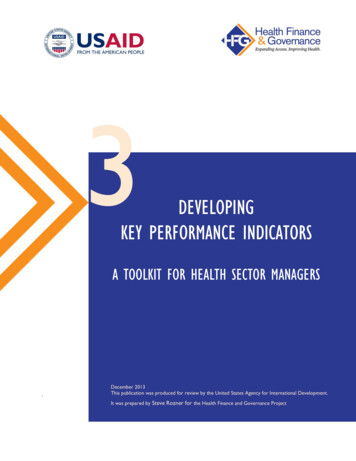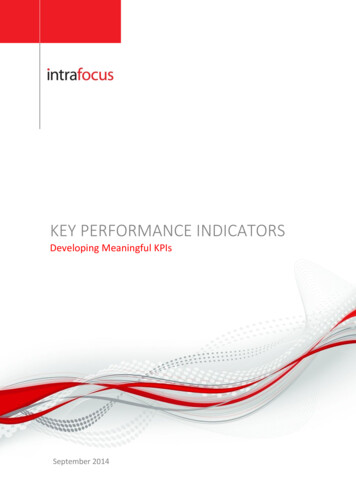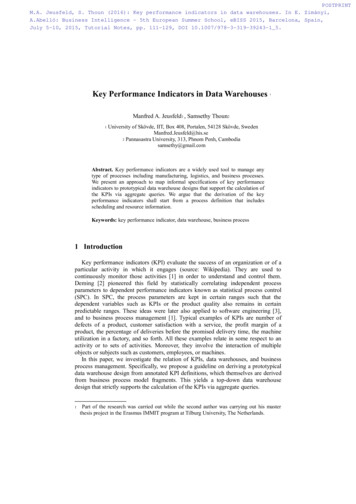
Transcription
Key Performance Indicatorsversion 100105Slide 1Key Performance IndicatorsMeasurable Facts toTune Execution of the Business PlanProf. Dr. F. Vanstapel, MD PhDLaboratoriumgeneeskundeUZ KULeuvenF. Vanstapel - Laboratory Medicine - University Hospitals - K.U.Leuven
Key Performance IndicatorsStructure of the Presentationversion 100105Slide 2Requirements of StandardsTeaching GoalsIntuitive IntroductionOperational DefinitionDefining generic KPI’sThe PDCA-cycleThe Learning OrganizationThe political arenaReinforcing desired outcomeWorking with peopleNuts and BoldsSummaryF. Vanstapel - Laboratory Medicine - University Hospitals - K.U.Leuven
Key Performance IndicatorsRequirements of Standardsversion 100105Slide 3Cited from ISO 15189:20074.12.4 Laboratory management shall implement qualityindicators for systematically monitoring and evaluating thelaboratory’s contribution to patient care.When this program identifies opportunities for improvement,laboratory management shall address them regardless of wherethey occur.Laboratory management shall ensure that the medicallaboratory participates in quality improvement activities thatdeal with relevant areas and outcomes of patient care.4.1.6 Laboratory management shall ensure that propercommunication processes are established within the laboratoryand that communication takes place regarding the effectivenessof the quality management system.F. Vanstapel - Laboratory Medicine - University Hospitals - K.U.Leuven
Key Performance IndicatorsRequirements of Standardsversion 100105Slide 4Cited from JCIQPS.3.2 Clinical monitoring includes those aspects of laboratoryservices selected by the leaders. Clinical monitoring data are used to study areas targeted forimprovement.F. Vanstapel - Laboratory Medicine - University Hospitals - K.U.Leuven
Key Performance IndicatorsRequirements of Standardsversion 100105Slide 5KPIDefinition1. Indicators forsystematically monitoring and evaluatingthe laboratory’s contributionin improving relevant areas and outcomes of patient care.2. Proper communication within the laboratoryregarding the effectiveness of the system.F. Vanstapel - Laboratory Medicine - University Hospitals - K.U.Leuven
Key Performance IndicatorsStructure of the Presentationversion 100105Slide 6Requirements of StandardsTeaching GoalsIntuitive IntroductionOperational DefinitionDefining generic KPI’sThe PDCA-cycleThe Learning OrganizationThe political arenaReinforcing desired outcomeWorking with peopleNuts and BoldsSummaryF. Vanstapel - Laboratory Medicine - University Hospitals - K.U.Leuven
Key Performance IndicatorsTeaching Goalsversion 100105Slide 7Pre-Test1. The introduction of KPI’s is importantfor compliance with ISO-15189 and other standardsfor policing the laboratory2. The introduction of KPI’s results inincreased motivation of employee’simproved performancea net benefit over overhead investment in KPI’sall of the abovenone of the abovewho secretly thought this ?The validity of the concept is questioned.KPI’s are seen as an instrument of repression / coercion.Why this negative premonition ?F. Vanstapel - Laboratory Medicine - University Hospitals - K.U.Leuven
Key Performance IndicatorsTeaching Goalsversion 100105Slide 8Pre-Test3. To setup KPI’sdefine new statisticsuse existing statisticsmake statistics available for the management reviewpost statistics periodicallypost statistics publiclyTeaching goal:By understanding the answer to the above questions,to understand- how to select (& validate) KPI’s- how to go about their implementationF. Vanstapel - Laboratory Medicine - University Hospitals - K.U.Leuven
Key Performance IndicatorsStructure of the Presentationversion 100105Slide 9Requirements of StandardsTeaching GoalsIntuitive IntroductionOperational DefinitionDefining generic KPI’sThe PDCA-cycleThe Learning OrganizationThe political arenaReinforcing desired outcomeWorking with peopleNuts and BoldsSummaryF. Vanstapel - Laboratory Medicine - University Hospitals - K.U.Leuven
Key Performance IndicatorsIntuitive Introductionversion 100105Slide 10Life Open Systems maintaining Steady States Physiology of PermanenceBiology is the prime exampleof the Science of Cybernetics(Norbert Wiener, Ross Ashby)F. Vanstapel - Laboratory Medicine - University Hospitals - K.U.Leuven
version 100105Key Performance IndicatorsIntuitive IntroductionSlide 11The glucose loopHepatic BranchLiver Glycogen“Randle Cycle”Glucose-FFA LoopSubstrate CompetitionHepatic OutputPlasmaGlucoseSubstrate-Product Cycle“Cori Cycle” Peripheral diposeLipid LipolysisPlasmaFFAPeripheral Branch“Cardiac Work”SedentaryF. Vanstapel - Laboratory Medicine - University Hospitals - K.U.Leuven
version 100105Key Performance IndicatorsIntuitive IntroductionThe insulin-glucose loop PancreasHepatic BranchIDDMLiverPlasmaInsulinInsulinGlucagon Glycogen “Randle Cycle”Glucose-FFA LoopSubstrate Competition Hepatic OutputGlucose-Insulin LoopPlasmaGlucoseSubstrate-Product Cycle“Cori Cycle” Peripheral DisposalSedentaryPlasmaLactateSlide 12GlycolysisAnaerobicLabourGlycogen MuscleAerobicInput(Remote)NIDDM LymphInsulinObesityStressAdiposeLipidInput LipolysisPlasmaFFAPeripheral Branch“Cardiac Work”SedentaryF. Vanstapel - Laboratory Medicine - University Hospitals - K.U.Leuven
Key Performance IndicatorsIntuitive Introductionversion 100105Slide 13Summary 1/2Physiology:The glucose-insulin axis works(feedback cycle) because:Your Business:The PDCA cycleis not a fictional construction- There is an underlyingmetabolic machinery at work- Your business is a system(aufbau & ablauf)- That system hasits own characteristic set-point- Hormonal control resetsthe set-point to a desirable level- That system has its ownlevel of performance- Management setsperformance goals- To that end a signal issensed & processed- A KPIis measured & communicated- Aberrant conditionsrequire action- In pathologic conditionsthe actual set-point differsF. Vanstapel - Laboratory Medicine - University Hospitals - K.U.Leuven
Key Performance IndicatorsIntuitive Introductionversion 100105Slide 14Summary 2/2The PDCA cycle is not a fictional construction, buta cybernetic system a system that can function by designIf your PDCA-cycle doesn’t work, it must be sick somewhere ?The patho-physiology of the PDCA-cycle is the topic of this lessonPATHOLOGYIDDM (Type-1 DM) : Interrupted loopNIDDM (Type -2 DM) : Insulin resistance & irresponsivenessSedentary lifestyle : No Pull on Glc-compartment .F. Vanstapel - Laboratory Medicine - University Hospitals - K.U.Leuven
Key Performance IndicatorsStructure of the Presentationversion 100105Slide 15Requirements of StandardsTeaching GoalsIntuitive IntroductionOperational DefinitionDefining generic KPI’sThe PDCA-cycleThe Learning OrganizationThe political arenaReinforcing desired outcomeWorking with peopleNuts and BoldsSummaryF. Vanstapel - Laboratory Medicine - University Hospitals - K.U.Leuven
Key Performance IndicatorsOperational Definition : Defining generic KPI’sversion 100105Slide 16Operational DefinitionIntelligent DesignStep 1. What do you want ? RelevanceStep 2. Ask the right question What is the problem to solve ?Step 3. Why doesn’t it work ? What were your tacit wrong underlying assumptions ?F. Vanstapel - Laboratory Medicine - University Hospitals - K.U.Leuven
Key Performance IndicatorsOperational Definition : Defining generic KPI’sversion 100105Slide 17Operational DefinitionIntelligent Design RelevanceStep 1. What do you want ?What are your Business Goals ?What is your core-business ?What do you want to achieve ?What do you need for that ?Recipe:Voice of the Customer (VOC)Balanced Score Board / SWOT analysisF. Vanstapel - Laboratory Medicine - University Hospitals - K.U.Leuven
Key Performance IndicatorsOperational Definition : Defining generic KPI’sversion 100105Slide 18Operational DefinitionIntelligent Design RelevanceStep 1. What do you want ?What are your Business Goals ?KPIDefinition 1Step 2. Ask the right question What is the problem to solve ?What are necessary conditions to achieve your goal ?Performance Limiting Variables determines the level of Value GeneratedOf course it is important to manage critical resourcesPATHOLOGYDon’t provide excusesto wait for “external” solutions,in stead of thinking-up innovative alternatives !!!F. Vanstapel - Laboratory Medicine - University Hospitals - K.U.Leuven
Key Performance IndicatorsOperational Definition : Defining generic KPI’sversion 100105Slide 19Operational DefinitionIntelligent Design RelevanceStep 1. What do you want ?What are your Business Goals ?KPIDefinition 1Step 2. Ask the right question What is the problem to solve ?What are necessary conditions to achieve your goal ?Performance Limiting Variables determines the level of Value GeneratedOf course it is important to manage critical resources: be aware of opportunity costs stick to your core-businessPATHOLOGYResources hijackedfor hidden agenda’s of stake-holdersF. Vanstapel - Laboratory Medicine - University Hospitals - K.U.Leuven
Key Performance IndicatorsOperational Definition : Defining generic KPI’sversion 100105Slide 20Operational DefinitionIntelligent Design RelevanceKPIDefinition 1Step 1. What do you want ?What are your Business Goals ?Step 2. Ask the right question What is the problem to solve ?What are necessary conditions to achieve your goal ?Performance Limiting Variable determines the level of Value GeneratedHow will you steer the course ?Value to be Generated translated into ObjectivesObjectives translated into Accountable TargetsPATHOLOGYKPIDefinition 2Performance IndicesTriad: (intangible) Values –Objectives –(tangible) Targets not definedF. Vanstapel - Laboratory Medicine - University Hospitals - K.U.Leuven
Key Performance IndicatorsOperational Definition : Defining generic KPI’sversion 100105Slide 21Operational DefinitionIntelligent Design RelevanceStep 1. What do you want ?What are your Business Goals ?Step 2. Ask the right question What is the problem to solve ?What are necessary conditions to achieve your goal ?How will you steer the course ?Step 3. What are your underlying assumptions ?Do you understand your business-model ?Do you understand stake-holder objectives ?PATHOLOGYAssumptions are tacitly taken for grantedand are never questionedF. Vanstapel - Laboratory Medicine - University Hospitals - K.U.Leuven
Key Performance IndicatorsOperational Definition : Defining generic KPI’sversion 100105Slide 22Understand your Business Model- Understand environment in which you operate- Understand Stake-holder ObjectivesMy Core Business is Laboratory Diagnosis- What is the Business Environment ?- What are Requirementsof the Diagnostic Process ?- What are Remediable Weaknessesin the Diagnostic Process ?F. Vanstapel - Laboratory Medicine - University Hospitals - K.U.Leuven
Key Performance IndicatorsOperational Definition : Defining generic KPI’sversion 100105Slide 23The Laboratory Diagnosis Business EnvironmentManaged Health Carenot a free market but a subsidised system5 parties: patients, insurers, governmenthealth care providers,Evolve towardsindustry (pharmaceutical, .)consolidationto maximizeshare ofsubsidiesGeneric KPI area’s:Costs per productF. Vanstapel - Laboratory Medicine - University Hospitals - K.U.Leuven
Key Performance IndicatorsOperational Definition : Defining generic KPI’sversion 100105Slide 24The Laboratory Diagnosis Business EnvironmentManaged Health Carenot a free market but a subsidised system5 parties: patients, insurers, governmenthealth care providers,Diagnostic assetsindustry (pharmaceutical, .)becomingcommoditiesWhat is your Vision ?Lab as a production platform ?Lab as a consultative service ?Generic KPI area’s:Costs per productConsultative servicesF. Vanstapel - Laboratory Medicine - University Hospitals - K.U.Leuven
Key Performance IndicatorsOperational Definition : Defining generic KPI’sversion 100105Slide 25The Laboratory Diagnosis Business EnvironmentInformation TechnologyTrue intelligent systemstechnically feasible5 parties: patients, insurers, governmenthealth care providers,industry (pharmaceutical, .)Governance by patient ofcentralized databasetechnically feasibleEvolve towards integratedwhole business systemsGeneric KPI area’s:Business integrationIT integrationF. Vanstapel - Laboratory Medicine - University Hospitals - K.U.Leuven
Key Performance IndicatorsOperational Definition : Defining generic KPI’sversion 100105Slide 26The Laboratory Diagnosis Business hat is your Vision ?Equitable Health Care ?The biggest piece of the cake ?Health Care ProvidersInsurersHealth Care IndustryGeneric KPI area’s:Market shareReturn / InvestmentF. Vanstapel - Laboratory Medicine - University Hospitals - K.U.Leuven
Key Performance IndicatorsOperational Definition : Defining generic KPI’sversion 100105Slide 27Understand your Business Model- Understand environment in which you operate- Understand Stake-holder ObjectivesMy Core Business is Laboratory Diagnosis- What is the Business Environmental ?- What are Requirementsof the Diagnostic Process ?- What are Remediable Weaknessesin the Diagnostic Process ?F. Vanstapel - Laboratory Medicine - University Hospitals - K.U.Leuven
Key Performance IndicatorsOperational Definition : Defining generic KPI’sversion 100105Slide 28Requirements of any diagnostic tool- Relevant- Accurate- Timely- Accessible- Understandable- Comparable- Coherent- Complete- Right price / costs purposive fit forpurposeSpecs / targetscfr. method validation fileF. Vanstapel - Laboratory Medicine - University Hospitals - K.U.Leuven
Key Performance IndicatorsOperational Definition : Defining generic KPI’sversion 100105Slide 29Logistic requirements of laboratory test- Relevant- Accurate- Timely- Accessible- Understandable- Comparable- Coherent- Complete- Right price/costs: position / function in care algorithm(s) ?: sampling design: timing / TAT with respect to care program(s): test request / reporting of results & conclusions: cumulative reports / reference & decision limits: over methods / time frames: with other tests & procedures: identification of lacking / censored data: low financial & user burden to patients & medical staff(non exhaustive list)Generic KPI area’s:Implementation of Care PathsConsultative servicesTAT, costF. Vanstapel - Laboratory Medicine - University Hospitals - K.U.Leuven
Key Performance IndicatorsOperational Definition : Defining generic KPI’sversion 100105Slide 30Analytical requirements of laboratory test- Relevant- Accurate- Timely- Accessible- Understandable- Comparable- Coherent- Complete- Right price/costs:: data processing / analytical traceability::: traceability to the applicable clinical studies: commutability over methods / time frames: diagnostic specificity of measurement:: process excellenceGeneric KPI area’s:Process ExcellenceCorrectionsiQC-problemsBalance Logistic / AnalyticalCost / objectRequirements not respected(non exhaustive list)PATHOLOGYF. Vanstapel - Laboratory Medicine - University Hospitals - K.U.Leuven
Key Performance IndicatorsOperational Definition : Defining generic KPI’sversion 100105Slide 31Understand your Business Model- Understand environment in which you operate- Understand Stake-holder ObjectivesMy Core Business is Laboratory Diagnosis- What is the Business Environment ?- What are Requirementsof the Diagnostic Process ?- What are Remediable Weaknessesin the Diagnostic Process ?F. Vanstapel - Laboratory Medicine - University Hospitals - K.U.Leuven
version 100105Key Performance IndicatorsOperational Definition : Defining generic KPI’sSlide 32RISK ANALYSIS - FAULT TREE in Laboratory DiagnosisRight test for the right patient at the right time ?Right interpretation at the right time ?Right consequential action at the right time retPATHOLOGYDiagnostic riptionLISRequestLabTestSampleReagentsGeneric KPI area’sCalibratorsTAT (B2B)Consultative services ControlsCritical value reporting setupcalibrateobtaininstalltrainmeasureISO/TS 22367:2008F. Vanstapel - Laboratory Medicine - University Hospitals - K.U.Leuven
Key Performance IndicatorsOperational Definition : Defining generic KPI’sversion 100105Slide 33RISK MANAGEMENT - METHOD VALIDATIONClinical ScenarioInventory of MeansSelection of MeansGeneric KPI:Outcome Care ProgramNumber to Treat / Days Hospitalization / Generic KPI:Diagnostic ProcessDiagnostic AcuityRequirements ?Suitability ?PatientSymptomsRisk Analysisdetermine medicallyImportant ErrorsTest RequestSamplingSelect AppropriateControl ProceduresAnalysisMethod Validation ProcessImplementationEvaluation ofClinical PathModel- differential diagnosis- measurement modelEvaluationTreatmentReportAnalytical ProcessGeneric KPI:Process ExcellencePATHOLOGYWrongFocusF. Vanstapel - Laboratory Medicine - University Hospitals - K.U.Leuven
Key Performance IndicatorsOperational Definition : Defining generic KPI’sversion 100105Slide 34Summary: Values – Objectives – Targets(Kaplan, oldersPATHOLOGYYour KPI is purposeless does not relate to owledgeF. Vanstapel - Laboratory Medicine - University Hospitals - K.U.Leuven
Key Performance IndicatorsStructure of the Presentationversion 100105Slide 35Requirements of StandardsTeaching GoalsIntuitive IntroductionOperational DefinitionDefining generic KPI’sThe PDCA-cycleThe Learning OrganizationThe political arenaReinforcing desired outcomeWorking with peopleNuts and BoldsSummaryF. Vanstapel - Laboratory Medicine - University Hospitals - K.U.Leuven
Key Performance IndicatorsOperational Definition : The PDCA-cycleversion 100105Slide 36Operational DefinitionIntelligent Design EffectivenessStep 3. What are your underlying assumptions ?Do you understand your business-model ?Do you understand stake-holder objectives ?You assume that “measuring” results in “a beneficial effect”What are necessary conditions for your KPIto give the right stimulus ? related to incentives ? do you have sufficient lay-way to operate ?KPIDefinition 3Incentives management ?No stickProject management ?PATHOLOGYto hit the dogF. Vanstapel - Laboratory Medicine - University Hospitals - K.U.Leuven
Key Performance IndicatorsOperational Definition : The PDCA-cycleversion 100105Slide 37Operational DefinitionKPI’s stem from Intelligent DesignConcept-drivenPlan5. Stay focused, Stay on track1. Define goal Value you want to create2. Define objective Target to aim atActDo3. Make achievements accountable4. Analyse deviation (variation) from set targetsFact-drivenCheckKPIDefinition 4FACTS likely to influence decisions RELEVANT EVIDENCERELEVANT EVIDENCE leading to a DECISION a DIAGNOSTIC PROCESSF. Vanstapel - Laboratory Medicine - University Hospitals - K.U.Leuven
Key Performance IndicatorsOperational Definition : The PDCA-cycleversion 100105Slide 38Operational DefinitionKPI ’s as a diagnostic processDiagnostic scenario’s- is your patient sick ?- does the patient respond to your therapy ?- does response persists ?bench markingproject managementprocess careA diagnosis only becomes a diagnosisby becoming consequential( to reinforce the right action at the right time )KPIDefinition 3F. Vanstapel - Laboratory Medicine - University Hospitals - K.U.Leuven
version 100105Key Performance IndicatorsOperational Definition : The PDCA-cycleSlide 39Operation
Key Performance Indicators Teaching Goals version 100105 Slide 7 1. The introduction of KPI’s is important for compliance with ISO-15189 and other standards for policing the laboratory 2. The introduction of KPI’s results in increased motivation of employee’s improved performance a net benefit over











